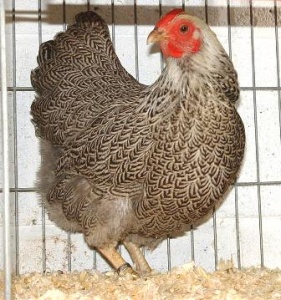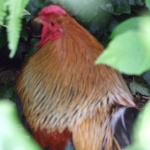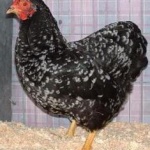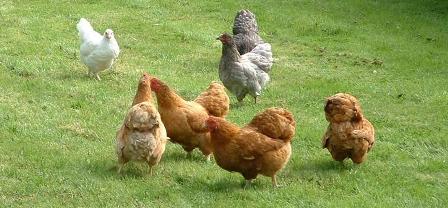 Due to pressure of work i have very few birds this year, But if anyone is looking for chickens later on i can point people to friends who may have some pullets later on. My aim has been to develop my own strains of Wyandotte bantams bred to the Poultry Club of Great Britain’s Wyandotte standard and my birds have all the traditional characteristics of the breed and are successfully shown. I have also selected for good health, vigour, an easy-going temperament and excellent layers of good sized eggs – size matters even in bantam eggs! Some strains lay eggs round the 13/4 – 2 ounce/55-60g mark. Spare cockerels make good eating but are are at least six months before they are a worthwhile size so need hanging for a few days.
Due to pressure of work i have very few birds this year, But if anyone is looking for chickens later on i can point people to friends who may have some pullets later on. My aim has been to develop my own strains of Wyandotte bantams bred to the Poultry Club of Great Britain’s Wyandotte standard and my birds have all the traditional characteristics of the breed and are successfully shown. I have also selected for good health, vigour, an easy-going temperament and excellent layers of good sized eggs – size matters even in bantam eggs! Some strains lay eggs round the 13/4 – 2 ounce/55-60g mark. Spare cockerels make good eating but are are at least six months before they are a worthwhile size so need hanging for a few days.
- My chickens are purely a hobby so i only have a few. “Sedgwick Hens and Bantams” only came about when Yellow Pages rang me by accident as I sometimes have point of lay pullets and hatching eggs available for sale (to careful fox-free homes) I decided to go along with their suggestion of having a free entry in the directory .
- I am located in West Sussex.
Putting the Spots into ‘Dots
During my projects into spots i quickly learnt it is not a simple subject. The varieties I have been developing and breeding fall into distinct types of spots but there is an overlap in patterns which show both types.
- Mottled: white spots on black or other self eumelanin colour.
- Spangled: big black (or other colour) spot on silver or gold
- Millefleur: white spots, with small black teardrop spangle.
- Mottled white spots on birds which are either completely buff or gold and black (or the silver versions) where some or none of the white mottles have black behind them; the closer a bird is genetically to pure buff the black band only appears in certain areas. The most extreme the bird is just buff with white spots.
- Mottled spangle : combination of spangle and mottle
- Tolbunt: white spots with lacing or non-standard distribution of black and gold
Partridge Wyandottes
 I still keep a few Partridge Wyandottes (pullet-breeder strain) which were the first chickens I owned as an adult. They were beautifully marked. I have been working on improving fertility and hatchability, which are now both very good.
I still keep a few Partridge Wyandottes (pullet-breeder strain) which were the first chickens I owned as an adult. They were beautifully marked. I have been working on improving fertility and hatchability, which are now both very good.
 I recently started a new strain to breed exhibition cockerels with lemon hackles. These are the most magnificent birds and I fully understand why they are referred to as “Royalty of the Showpen” See picture above.
I recently started a new strain to breed exhibition cockerels with lemon hackles. These are the most magnificent birds and I fully understand why they are referred to as “Royalty of the Showpen” See picture above.
The project is still in it’s early stages.
And the rest:
My good old broodies. Big fluffy, buffy red jobs and the occasional white which comes from my partridges.


